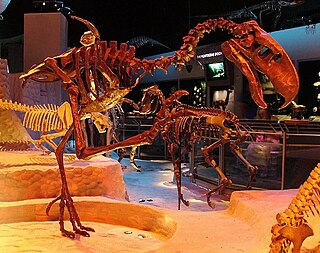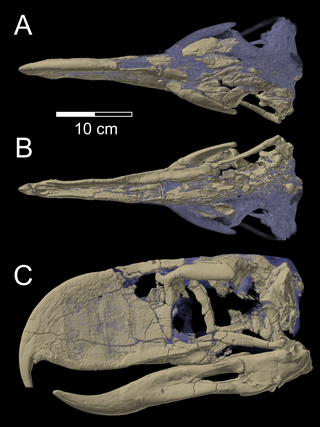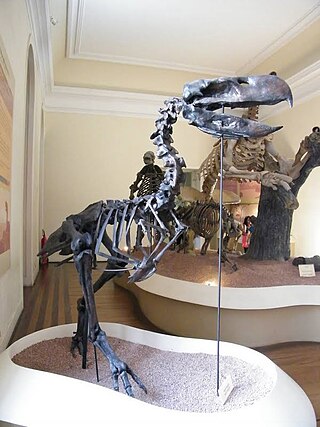
The seriemas are the sole living members of the small bird family Cariamidae, which is also the only surviving lineage of the order Cariamiformes. Once believed to be related to cranes, they have been placed near the falcons, parrots and passerines, as well as the extinct Phorusrhacidae. The seriemas are large, long-legged territorial birds that range from 70–90 cm (28–35 in) in length. They live in grasslands, savanna, dry woodland and open forests of Brazil, Bolivia, Argentina, Paraguay and Uruguay. There are two species of seriemas, the red-legged seriema and the black-legged seriema. Names for these birds in the Tupian languages are variously spelled as siriema, sariama, and çariama, and mean "crested".

Phorusrhacids, colloquially known as terror birds, are an extinct family of large carnivorous flightless birds that were among the largest apex predators in South America during the Cenozoic era; their conventionally accepted temporal range covers from 53 to 0.1 million years (Ma) ago.

Titanis is a genus of phorusrhacid, an extinct family of large, predatory birds, in the order Cariamiformes that inhabited the United States during the Pliocene and earliest Pleistocene. The first fossils were unearthed by amateur archaeologists Benjamin Waller and Robert Allen from the Santa Fe River in Florida and were named Titanis walleri by ornithologist Pierce Brodkorb in 1963, the species name honoring Waller. The holotype material is fragmentary, consisting of only an incomplete right tarsometatarsus and phalanx, but comes from one of the largest phorusrhacid individuals known. In the years following the description, many more isolated elements have been unearthed from sites from other areas of Florida, Texas, and California. It was classified in the subfamily Phorusrhacinae, which includes some of the last and largest phorusrhacids like Devincenzia and Kelenken.

Andalgalornis is a genus of flightless predatory birds of the extinct family Phorusrhacidae that lived in Argentina. The type and only species is A. steulleti.

Brontornis is an extinct genus of giant bird that inhabited Argentina during the Early to Middle Miocene. Its taxonomic position is highly controversial, with authors alternatively considering it to be a cariamiform, typically a phorusrhacid or an anserimorph.

Mesembriornis is a genus of intermediate-sized phorusrhacids that grew up to 1.5 metres (4.9 ft) in height. They represent a well-distinct lineage of terror birds, differing from the massive large groups and the smaller Psilopterinae. In general proportions, they most resembled the Patagornithinae which flourished somewhat earlier, mainly to the south of the range of Mesembriornis. Fossils of the terror bird have been found in Montehermosan deposits of the Monte Hermoso Formation, as well as the Andalgala Formation and Chapadmalal Formation in Argentina.

Paraphysornis is an extinct genus of giant flightless terror birds that inhabited Brazil during Late Oligocene or Early Miocene epochs. Although not the tallest phorusrhacid, Paraphysornis measured up to 1.4 metres tall at the hips and weighed around 180–240 kilograms (400–530 lb). It was also a notably robust bird, having short and robust tarsal bones not suited for pursuit hunting.

Kelenken is a genus of phorusrhacid, an extinct group of large, predatory birds, which lived in what is now Argentina in the middle Miocene about 15 million years ago. The only known specimen was discovered by high school student Guillermo Aguirre-Zabala in Comallo, in the region of Patagonia, and was made the holotype of the new genus and species Kelenken guillermoi in 2007. The genus name references a spirit in Tehuelche mythology, and the specific name honors the discoverer. The holotype consists of one of the most complete skulls known of a large phorusrhacid, as well as a tarsometatarsus lower leg bone and a phalanx toe bone. The discovery of Kelenken clarified the anatomy of large phorusrhacids, as these were previously much less well known. The closest living relatives of the phorusrhacids are the seriemas. Kelenken was found to belong in the subfamily Phorusrhacinae, along with for example Devincenzia.
Physornis is an extinct genus of giant flightless predatory birds of the family Phorusrhacidae or "terror birds", most closely related to Paraphysornis, that lived in Argentina. The type species is P. fortis. It lived during the Middle to Late Oligocene (Deseadan). Few fossils are known, but the available material suggests that Physornis was one of the largest phorusrhacids.

Devincenzia is an extinct genus of giant flightless predatory birds in the family Phorusrhacidae or "terror birds" that lived during the Early Miocene (Deseadan) Fray Bentos Formation of Uruguay, Late Miocene (Huayquerian) Ituzaingó Formation, Early Pliocene (Montehermosan) of Argentina, and possibly the Early Pleistocene Raigón Formation of Uruguay. The type species D. pozzi was formerly known as Onactornis pozzi. The largest possible specimen weighed up to 350 kilograms (770 lb), making it one of the largest phorusrhacids and carnivorous birds known.

Patagornis is a genus of extinct flightless predatory birds of the family Phorusrhacidae. Known as "terror birds", these lived in what is now Argentina during the Early and Middle Miocene; the Santa Cruz Formation in Patagonia contains numerous specimens. Patagornis was an agile, medium sized Patagornithine and was likely a pursuit predator.

Andrewsornis is an extinct genus of giant flightless predatory birds of the family Phorusrhacidae or "terror birds" that lived in Oligocene Argentina. Fossils have been found in the Sarmiento Formation, and possibly the Agua de la Piedra Formation.
Paleopsilopterus is an extinct genus of giant flightless predatory birds within Cariamiformes. It is usually attributed to the subfamily Psilopterinae of the family Phorusrhacidae, or "terror birds", though doubts about such an identity have arisen multiple times. It lived around 53 to 50 million years ago (Itaboraian) in Brazil, during the Early Eocene. The only known species is Paleopsilopterus itaboraiensis. Fossils of Paleopsilopterus have been found in the Itaboraí Formation at São José de Itaborai in Rio de Janeiro state.

Psilopterus is an extinct genus of phorusrhacid from the Middle Oligocene to possibly the Late Pleistocene of Argentina and Uruguay. Compared to other phorusrhacids, members of the genus are both relatively gracile and diminutive, and include the smallest known species of terror bird: with the head raised P. bachmanni was 70–80 centimeters (2.3–2.6 ft) in height and weighed about 5 kilograms (11 lb), while the largest members of the genus were only about 8 kilograms (18 lb). The birds resemble the modern cariama, except with a heavier build and considerably smaller wings. The strong morphological similarity between the claws of the predatory cariama and Psilopterus, both of which are sharp, curved, and laterally compressed, may indicate they were used to strike prey. Tonni and Tambussi also suggested that, in contrast to the other, larger terror birds, Psilopterus could use their claws to climb trees, and could even fly, but this has been rejected in more recent literature. Fossil finds in Uruguay indicate the genus may have survived until 96,040 ± 6,300 years ago, millions of years after the larger phorusrhacids became extinct.

Cariamiformes is an order of primarily flightless birds that has existed for over 60 million years. The group includes the family Cariamidae (seriemas) and the extinct families Phorusrhacidae, Bathornithidae, Idiornithidae and Ameghinornithidae. Though traditionally considered a suborder within Gruiformes, both morphological and genetic studies show that it belongs to a separate group of birds, Australaves, whose other living members are Falconidae, Psittaciformes and Passeriformes.

Llallawavis scagliai is a large, extinct predatory bird from Pliocene Argentina. Its fossil is the most complete fossil of a phorusrhacid yet found.

Bathornithidae is an extinct family of birds from the Eocene to Miocene of North America. Part of Cariamiformes, they are related to the still extant seriemas and the extinct Phorusrhacidae. They were likely similar in habits, being terrestrial, long-legged predators, some of which attained massive sizes.

The Cerro Azul Formation, also described as Epecuén Formation, is a geological formation of Late Miocene age in the Colorado Basin of the Buenos Aires and La Pampa Provinces in northeastern Argentina.
Chunga incerta is an extinct species of cariamid bird which inhabited the Pliocene of the central-eastern Southern Cone of South America. It belongs to the genus Chunga, today only represented by one species, Chunga burmeisteri.
Rhea mesopotamica is an extinct species of bird in the genus Rhea, whose living species are known as suris, rhea, or choiques. It lived in the Southern Cone of South America.



















